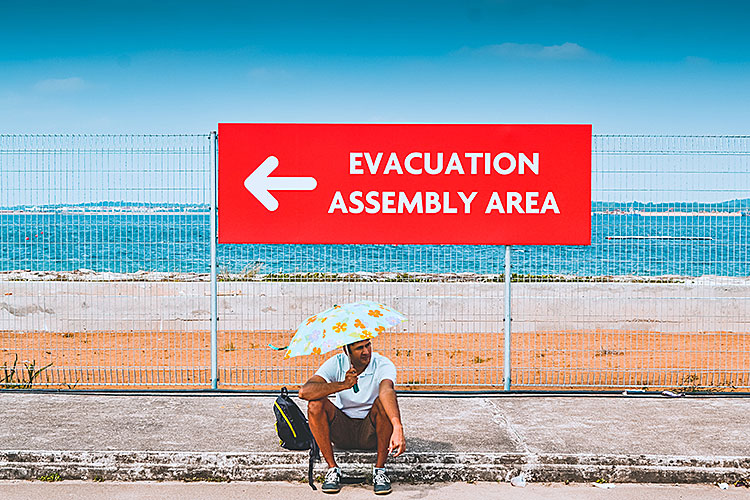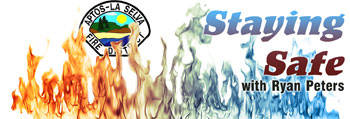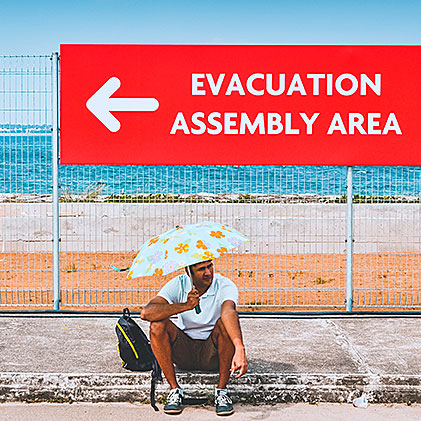 Having a Plan in Place is Key for Safety
Having a Plan in Place is Key for Safety
By Ryan Peters, Fire Captain, Aptos-La Selva Fire Protection District
 It’s hard to believe that we’re already well into July! I hope everyone is enjoying the summer season so far.
It’s hard to believe that we’re already well into July! I hope everyone is enjoying the summer season so far.
A couple of months ago as we said goodbye to Spring, we addressed the importance of making sure your home is protected from the risk of wild fire through weed abatement, defensible space, and fuel control. All very important things for us to consider, as we get deeper into the 2019 fire season.
Aptos and the surrounding communities are no stranger to large-scale wild fires. Many of you may recall the Trabing Fire that occurred in June of 2008. Record temperatures sizzled into triple digits that day, as a small fire quickly grew to disastrous proportions along the inland side of Highway 1 in the southern portion of Santa Cruz County. Fire conditions were dangerous and dynamic, as the fire would eventually destroy 26 homes and 49 outbuildings.
While the fire’s total size (630 acres) may not have been large in terms of area, the fire was located in acres of dry unburned grass and brush (fuel) coupled with many homes built there. This interface of wild land and residential areas are common in most of California’s 58 counties.
 Aptos and the surrounding neighborhoods include plenty of these interface zones which we at Aptos-La Selva Fire District address every year for safety and fire pre-planning. Our main focus each spring and summer is to mitigate the threat and consequences of fire in these interface areas.
Aptos and the surrounding neighborhoods include plenty of these interface zones which we at Aptos-La Selva Fire District address every year for safety and fire pre-planning. Our main focus each spring and summer is to mitigate the threat and consequences of fire in these interface areas.
This month, I thought I’d speak to the idea of having an evacuation plan in place if a wild fire were to threaten your neighborhood. While an evacuation plan for wild fire will also address other potential disasters such as earthquakes, floods, and other large scale incidents, knowing how to effectively (and safely) evacuate is critical to making sure that you and your loved ones are protected and prepared.
First ask yourself: What would we do if an evacuation order were issued for your neighborhood? Would we know what to do? What would the first order of action be for you and your family? Sadly, in many large-scale wild land fires, firefighters have seen the tragic loss of life that occurs when neighborhoods are unprepared for when it is time to evacuate.
The first thing to do is to plan where you and your family would go if you were advised to evacuate your neighborhood. Identify safe places you could go ahead of time and develop a family/household communication and re-unification plan. This is important to make sure everyone in your family is on the same page in the event you are separated when a disaster happens. Please keep in mind that cell phones may not work and that your ability to communicate in conventional ways during a disaster could be limited.
Another critical aspect of an evacuation plan is to know your area. Be familiar with alternate routes in and out of your neighborhoods. Again, if cell phone towers are compromised due to a fire, your ability to utilize mapping services will be limited or may not work at all. Assemble a “go bag” that you can carry on foot, which keeps all critical personal items you may need.
Keep important documents, prescription medications, glasses, and other necessary items in a ready mode in case you need to leave fast. The last thing we want is to forget critical belongings, or worse, delay an emergency evacuation because we’ve lost track of where we’re keeping those critical items. Be ready to go!
Consider always keeping a full tank of fuel in your vehicle and remember that in certain situations, you may not be able to drive your car due to road closures or traffic congestion. Plan to address the needs of your pets and, if you own livestock or horses, be familiar with the safe places you can take them in the event of an evacuation. This was a very critical aspect to the evacuation during the Trabing Fire incident.
If time allows you to do so, prior to leaving the house, get in contact with any family members living out of the area and inform them of your plan. Secure your home by locking all doors and windows. Unplug all electrical equipment such as radios, televisions, and small appliances. Leave freezers and refrigerators plugged in unless there is risk of flooding.
If there is damage to your home and you are instructed to do so, please shut off your gas, water, and electricity. As you are leaving, tying a towel or something similar to the doorknob will tell emergency services that your house is secured and evacuated.
Lastly, if possible include your neighbors in your plan. A neighborhood that prepares together thrives together during challenging times. I believe our community can be well prepared and ready for any type of disaster. Let’s continue to work together in our neighborhoods as we put a plan in place that makes sure everyone goes home safe!
•••
For more information on public evacuations and disaster preparedness please visit www.ready.gov or download the mobile FEMA app for smartphones. See www.fema.gov for more information.
This application provides alerts and information during disasters and large-scale incidents. You may also visit www.aptosfire.com for more on how you can stay prepared and informed.

